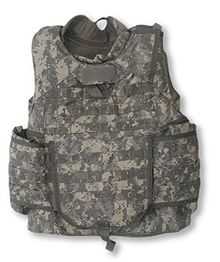Gold Flex
 | |
| Company | Honeywell |
|---|---|
Gold Flex is a fabric manufactured by Honeywell from synthetic fiber and often used in ballistic vests and body armor. Gold Flex is lighter then Kevlar, Twaron and other Ballistic material, yet offers the most bullet proof protection. The material used is very flexible and strong as well which provides comfort for the individual using it and is also tolerated for longer periods of time. Gold Flex is a laminated fabric consisted of crossed-laid fibers. When an object strikes this material a "web" of its clusters absorb the impact by a good percentage and minimizes penetration. Since this is a fibre-based creation, all fibres on the GoldFlex works together on the vest or material to stop the impact.
Protection
GoldFlex gives great resistance to abrasion and resists organic solvents making itself nonconductive, low flammable, and a great fabric that has an amazing resistance to elevated temperatures. Its degradation point starts from 500°C and it has no melting point. It is sensitive to salts, acids, and ultraviolet radiation. When it comes to the static build-up in the body it is prone to it as well [1]. Protection is also based on the pressure of the impact. Some of these fabrics are only designed with hand-guns in mind basically making anything with a bigger calibre a threat potential. One cannot wear a GoldFlex and expect a .50 cal to be stopped from penetrating it. Also GoldFlex is not the only material that is responsible for minimizing penetration and absorbing the attack. Along with GoldFlex there are other layers on top of this fabric to ensure that the object does not penetrate through the material.
Armor
When a bullet strikes the body armor, it hits ballistic fiber which is strong enough to not let it through. This fibre helps absorbing and dispersing the impact that has been made by the bullet to the body armor. This process continues and every layer of this material is effected until the bullet has reached to a full stop. All layers combined together form a larger area of the impact to disperse and keep the bullet from penetrating the carrier. This helps reducing the risk of blunt force trauma also known as injuries to internal organs.
Production
| Characteristics | ||
|---|---|---|
| Roll Weight | Pounds | 122.7 |
| Width | Inches | 63.0 |
| Length | Feet | 492 |
| Total Area Density | Testing Method | ASTM D3776-96 (2002) |
Comparison with other materials
| Kevlar Chemical Composition | |
|---|---|
 A Chemical Structure of the fabric used in a Kevlar |
Kevlar is five time stronger than steel of equivalent weight. It was invented by a Polish-American chemist Stephanie Kwolek and introduced in the 1970s. It is used for body armor and racing tires but is more expensive than Gold Flex. Twaron is another alternative to Gold Flex but is not much in demand. Occasionally several materials are used in one product.
See also
- Ballistic vest
- Kevlar
- Ultra-high-molecular-weight polyethylene
References
- Aramid
- Ioffe Institute Databases
- WebElements.com
- ChemSpider - The free chemical database, The Royal Society of Chemistry
- Honeywell manufacturer of the Gold Flex fabric.
- About Gold Flex.
- Information
"Bullet Proof Shop". bullet proof shop. Retrieved 4 April 2013. Unknown parameter |news service= ignored (help)
"Rhino Armor". rhino armor. Retrieved 4 April 2013. Unknown parameter |news service= ignored (help)
"Bullet Proof Vest History". bullet proof vest history. Retrieved 4 April 2013. Unknown parameter |news service= ignored (help)
"Blanket of Gold Flex". interamer. Retrieved 4 April 2013. Unknown parameter |news service= ignored (help)
"Kevlar". Retrieved 4 April 2013. Unknown parameter |news service= ignored (help)
External links
- EINECS (European INventory of Existing Commercial chemical Substances)
- Ratio International Corporation Crystal Structure Catalogue
- http://www.cas.org/products/sfacad/index.html
- http://webbook.nist.gov/chemistry/
- Spectral Database for Organic Compounds, SDBS
- http://chemfinder.cambridgesoft.com/
- http://www.astm.org American Society for Testing and Materials (ASTM)